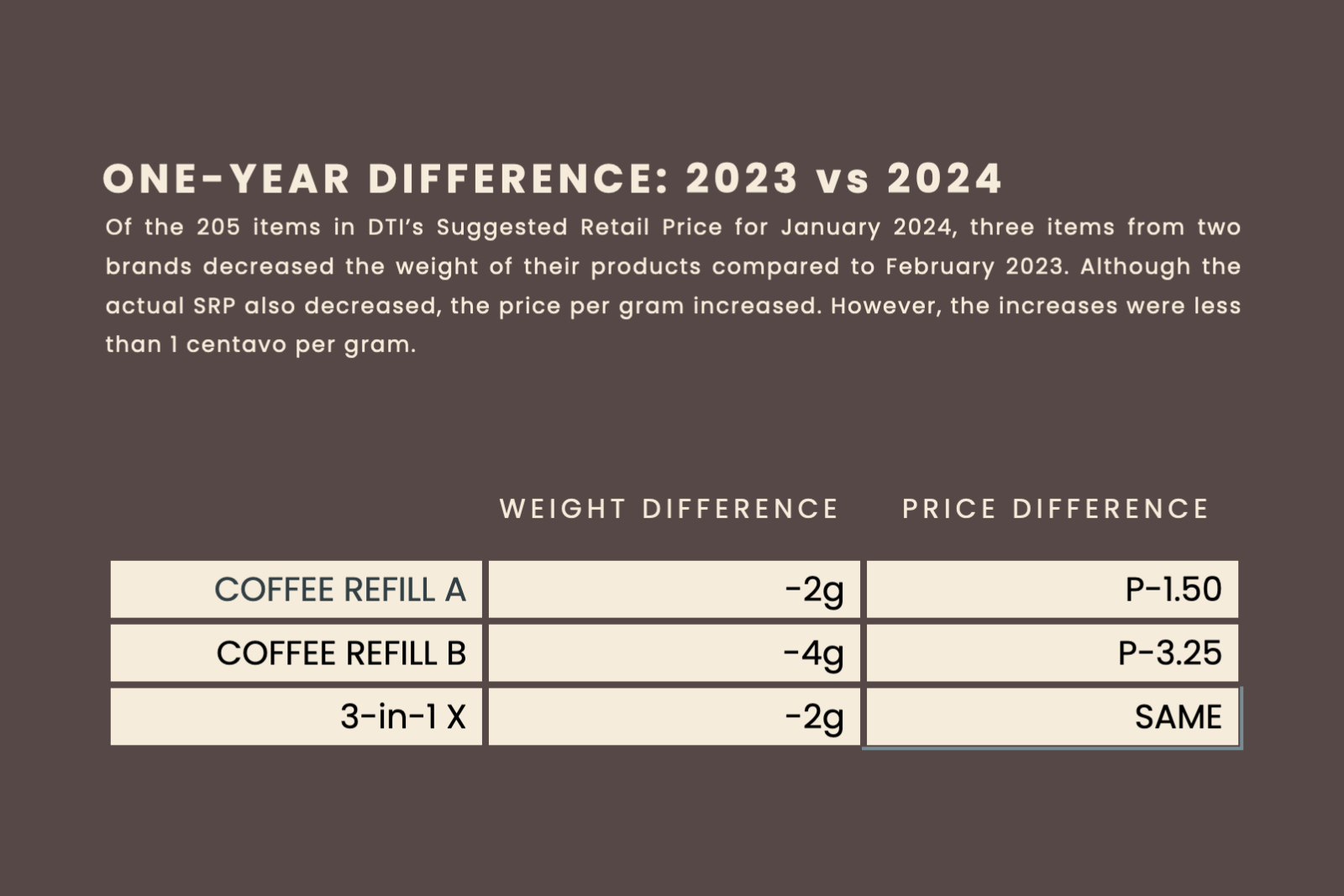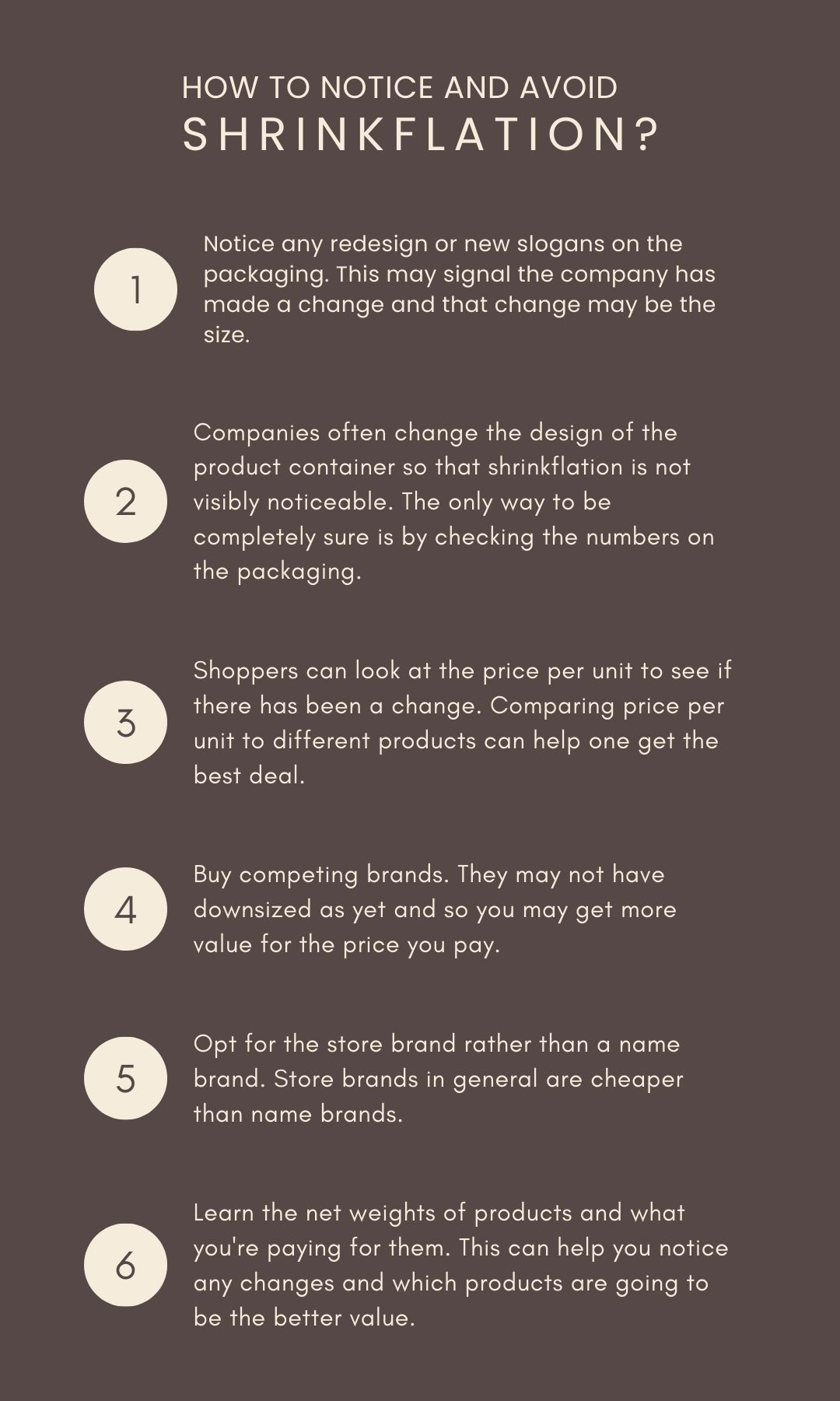We use cookies to ensure you get the best browsing experience. By continued use, you agree to our privacy policy and accept our use of such cookies. For further information, click FIND OUT MORE.
When you pay
the same for less
Ever walked into a supermarket and realized that it's not the same as it was, not only according to Harry Styles, but also your wallet?
Imagine picking out your favorite pack of candies and wondering why it feels so much lighter than it used to be.
Or eating your top-tier pandesal but realizing there's not much to chew on and having to buy more pieces to fill up?
The answer is shrinkflation, a technique manufacturers and retailers use to cope with inflation: shrinking their products but keeping the price the same. In other words, the cost of a product goes up even when the price on the container remains the same.
Shrinkflation has been on the mind of even US President Joe Biden, who in this year’s State of the Union address slammed shrinkflation as "a rip-off."
“Some companies are trying to pull a fast one by shrinking the products little by little and hoping you won't notice. Give me a break. The American public is tired of being played for suckers. I'm calling on companies to put a stop to this. Let's make sure businesses do the right thing now,” he said.

Source: DTI
Examples of shrinkflation can be spotted on the Department of Trade and Industry’s (DTI) list of suggested retail prices for necessities and prime commodities.
One example is a coffee product that shrank the weight of its sachet from 20 grams in February 2023 to 18 grams in January 2024 but maintained the same suggested retail price (SRP), according to GMA Integrated News Research.
Another is a milk brand that decreased the weight of its product from 150 grams to 135 grams but retained its price.
Steven Cua, the president of the Philippine Amalgamated Supermarkets, said the Philippines is the “epitome” of a “sachet-ifying” economy.
“Kung sachet, lahat ng items may sachet [if one has a sachet, all the products will have sachet versions]. So we are the epitome of the economy that just downsizes, for years," Cua said.
From necessities like soap, bread, and milk to treats like ice cream, many popular products have diminished under shrinkflation. Consumers are finding that their money is purchasing less. However, said Cua, shrinkflation is also a gamble for companies.
"Shrinkflation is not an easy decision for the manufacturers; they have to make sure that the can or container hindi kakalog-kalog [will not sound hollow when shaken]. It also costs money to program their manufacturing. Shrinkflation is a choice; it's a strategy. It's a decision which may also cause them a loss," he said.
The COVID-19 pandemic pushed production prices up, leaving manufacturers to either increase product prices or downsize, he added.
"Everybody is afraid of losing market share, so by downsizing or practicing shrinkflation, they start to lose a number or amount of market share by simply increasing price. Pricing is a decision, it's a strategy," Cua added.

Source: DTI
The effectiveness of this strategy varies, as many consumers do not actually check the size of a product and are often more focused on product prices.
However, not every product can be shrunk; especially since there are prescribed standards in size and grammage for different products. But some products also do not undergo shrinkflation because it’s not needed for their market.
“Ang objective naman kasi ng shrinkflation, makapagbenta pa rin sa affordable na presyo. Na hindi itataas ‘yung presyo pero liliit ‘yung serving, ‘yung size ng produkto,” said Rizal Commercial Banking Corporation (RCBC)’s Treasury Group chief economist Mike Ricafort.
(The objective of shrinkflation is to still be able to sell at an affordable price. So the price won’t increase but the serving will be smaller.)
“Kapag ang target market ng isang business o manufacturer ay mayayaman, ang option nila price increase, pero kung ‘yung market nila ay masa, yung mahihirap, doon nagkakaroon ng alteration, kung kailangan bang liitan ang size o mag-isip ng ibang intervention.”
(When a business or manufacturer’s target market is the rich, their option is the price increase. But when their market is the lower-income sector, that’s where they choose alteration, whether it’s decreasing the side or if they can think of another intervention.)
Jerome Cañete, a 19-year-old malunggay pandesal vendor in Quezon City, said reducing the size of his pandesal did not affect his daily earnings.
“Di nagbago presyo, pero lumiit. Lumiit kasi ang mahal ng asukal, hindi rin bumaba presyo ng harina. Pero hindi naman naapektuhan yung benta,” he said.
(The price was the same, but the pandesal became smaller. It’s smaller because sugar is so expensive, and the cost of flour also hasn’t gone down. But the sales haven’t been affected.)
Since shrinkflation is a business strategy, the Department of Trade and Industry allows manufacturers to have the option to reduce the size or weight of their products instead of increasing product prices.
“’Yang pagbawas ng grammage while charging the same price, choice ‘yan ng manufacturer kung worth it ba. Wala kaming control sa desisyon ng manufacturer. We’re not interfering with the market forces, ang role ng DTI [the DTI’s role] is consumer protection, consumer rights,” said DTI Trade Assistant Secretary for Consumer Protection Group Amanda Nograles.
(Reducing the grammage while charging the same price, that’s the manufacturer’s choice to do if it feels it’s worth it. We don’t have control over manufacturers’ decisions.)
She said the DTI is only mandated to monitor and ensure that there is a sufficient supply of necessities and prime commodities at reasonable prices.
The DTI does not control the product price adjustments that are submitted by manufacturers. Nograles said the department checks if there is sufficient basis for the price adjustments, such as if they are in accordance with the price of raw materials and global prices.
“Pero wala talaga tayong control para sabihing hanggang dito lang ang taas, hanggang dito lang ang baba. Ang DTI kapag mayroong nagma-manipulate, illegal price manipulation ‘yan, pinananagutan natin ‘yan,” she added.
(But we have no control to say the price should only go up to here, or down to here. But when there is illegal price manipulation, the DTI will make sure there is accountability.)
“Ini-implement natin ang Price Act, ang Consumer Act and many others to protect the consumers na kapag bumili sila ng isang produkto, kailangan they get their money’s worth, diba? ‘Yan yung binabatayan natin,” she added.
(We implement the Price Act, the Consumer Act, and many others to protect the consumers so that when they buy a product, they get their money’s worth. That’s what we monitor.)
Professor Emmanuel Leyco, an economist and a former Social Welfare and Development undersecretary, has urged a wage hike, saying that the value of labor has been left behind.
And for the Filipinos whose wages are stagnant, shrinkflation is a particularly hard blow.
“Stagnant wages erode the purchasing power of families who have to deal with rising prices. If the products' volume or weight are reduced, families may choose to stay away from the market because of their weakened purchasing power,” he told GMA News Online.
Housewife Irma Pabustan, 55, has a monthly budget of P5,000 for groceries. She usually purchases canned goods, instant coffee and noodles, and some bathroom essentials.
“Kung liliit nang liliit ‘yung laman ng mga item, baka pang-ilang araw lang ‘yun. Pag naubos agad, kailangan pang bumili na naman. E ako, twice a month lang ako nag-go-grocery, pero dahil agad nauubusan ng stock, kailangan ko pang bumili ulit, mas napapamahal,” she said.
(If items keep getting smaller, there’ll only be enough for a few days. And when you run out right away, you have to buy again. I only go to the grocery twice a month, but because the sock runs out faster now, I have to go and buy again, so things become more expensive.)
Pabustan said P500 worth of instant noodles and canned goods used to be a week’s worth of merienda for their household of four.
“Pero parang ngayon kapag magluluto ako ng instant noodles, dalawa agad kasi bitin ‘yung isa. Parang sobrang konti na kasi ‘yung laman,” she said.
(But now when I cook instant noodles, I have to cook two because one isn’t enough anymore. There’s not enough in one pack.)
If shrinkflation isn’t against the law, what can we do about it?
Pabustan said she goes for cheaper brands when she can. “Tumaas o bumaba man ang presyo, dumami man yan o kumonti, ganoon pa rin naman, kailangan pa ring bilhin kasi kailangan sa bahay e. Siguro, kaniya-kaniyang diskarte na lang kung saan makakamura,” she stressed.
(Whether the price goes up or down, or there’s more in the package or less, you still have to buy it because you need it in the house. Everyone just has their strategy to keep their spending down.)
The experts we talked to offered the same advice: compare prices. And in the end, that’s how consumers wield what power they have in the situation: by taking their business elsewhere.
“In terms sa market, parati nating sinasabi na exercise your right to choose, kasi hindi lang naman ‘yan yung apektadong produkto na pwedeng bilin, pare-pareho namang dekalidad. Yun ang laging pinapayo natin sa consumers,” said the DTI’s Nograles.
(We always say to exercise your right to choose, because there are other brands that you can try that are of the same quality. That’s what we advise consumers.)

Ricafort said that shrinkflation involves both companies and consumers making adjustments, but at least competition means that buyers still have the power of choice. “Nag-a-adjust ang companies para mabigyan ng choice ang consumers natin na angkop sa budget at kailangan nila,” he said.
(Companies adjust to give consumers choices that could fit their budget better.)
“‘Yung iba, naghahanap ng ibang brand, kung maliit o mahal na ‘yung dati nilang binibili. E minsan pareho lang naman, you get the same quality, and quantity at a lower price sa alternatives, local man o hindi,” he also said.
(Some buyers switch brands when the product they buy becomes too small or too expensive. And sometimes with the alternatives the product is the same, you get the same quality, and quantity at a lower price, whether local or not.)
"Kapag meron kang [When you have] financial constraints, limitations, then it may be good to experiment with other brands, you can go first with other brands and see how it's cheaper than the brand you are buying. If it works for you, you just save so much. The label is marketing," Cua said. —BM, GMA Integrated News
